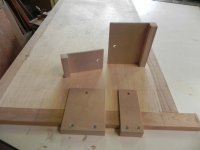I am making some built-in bookcases. The bookcases will be made of plywood edged with solid wood, using tongue and grove joinery. My primary interest in edging the plywood this way is to add strength to the shelves.
However, now that I own a Festool Domino system, I was wondering if using dominoes would provide as much strength to the shelve as tongue and grove would.
Advice, please.
However, now that I own a Festool Domino system, I was wondering if using dominoes would provide as much strength to the shelve as tongue and grove would.
Advice, please.


